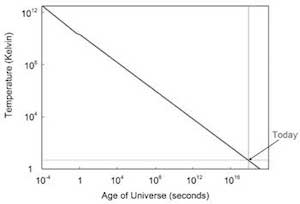Big Hiss Missed by Others
One of the biggest surprises from the recent discovery of the Big Bang's faint background radiation is how many times others have missed it.

Image Credit: Based on plot from Dicke et al., ApJ, 142, 414 (1965)
Plot of the temperature history of the universe as predicted by Dicke and Peebles. Their work led Penzias and Wilson to determine that their signal was the remnant radiation of the big bang.
As recently as last year, Russian scientists Andrei Doroshkevic and Igor Novikov published a study on the physics of the Big Bang. They guessed correctly that if the big bang happened, the remaining heat would now be between 1 and 10 degrees Kelvin. They even proposed using sky temperature measurements already made in 1961 by Edward Ohm to see if the signal could be found in them. Ironically, Ohm had gathered that same data using the Holmdel horn antenna. This is the same antenna Arno Penzias and Robert Wilson used to identify the 3.5 degrees Kelvin background radiation of the Big Bang.
Ohm had already identified in his data what seemed to be a 3.3 degrees Kelvin background radiation. He assumed it was coming from the antenna mechanism itself, not from space. Since Penzias and Wilson subtracted out the antenna's own microwave radiation, they were able to say with far more confidence that the faint excess radiation truly came from space.
There were two other near misses as well. Ten years ago Émile Le Roux reported a microwave background radiation of 3 degrees Kelvin, plus or minus 2 degrees at the Nançay Radio Observatory. In 1957 it was Tigran Shmaonov who nearly made the discovery. He reported measuring background temperature of 4 degrees Kelvin, give or take 3 degrees.
The missing piece in both Le Roux and Shmaonov's work was they did not connect their observations to what the Big Bang theory predicted as early as 1948. They had the right data but didn't have a theory that made sense of them. It's probably safe to say that Penzias and Wilson would have had the same problem if their neighbors at Princeton University had not recognized their discovery as the background radiation predicted by the Big Bang theory. •



